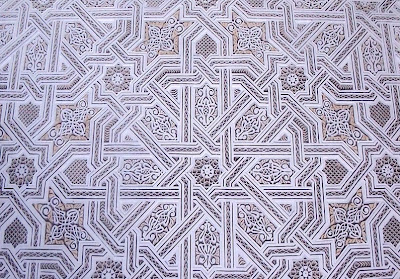the plaster
In Morocco, the plaster is worked in sculpture or is
engraved to compose most of the Moroccan decorations, recovering the high part
of the mural zelliges and very often the ceilings Having a time of relatively
long drying, it makes it possible to leave the craftsman to carve and to work
it; upon request, it could be corrected after simple damping.
The plaster can be carved vertically or in parallel compared
to the plan of the wall. It is very often raised of a clearer colour or a
gilding.
The plaster is spread out in thick layers of a few
centimetres over surface to decorate. This thickness varies according to the
quality of desired work, generally 3 to 4 centimetres.
The ghabbar trace of the reasons to the rule or the compass
but generally using gauges or of commonplaces to the stencil key set.
The maallem ghabbar is a respectful draughtsman of the
regulating layouts. It must as be at ease in meticulous details of illumination
or penmanship as in architectural large surfaces, in frontages particularly.
Penmanship takes a considerable importance in the sculpture
of the plaster where it takes all its blooming.
The plaster is very snuffed for equipped the columns; it is
used to carve capitals with curved reason or calligraphic and floral
interlacings of arabesque.
Another style of the manifestation of volume in Islamic art,
the mouquarnas kinds of stalactites which go down from the ceilings, comparable
has thimbles turned over furnishing the under-surface with the arcs or entirely
papering the vaults.






Comments
Post a Comment